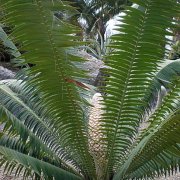Care of the cycad Encephalartos altensteinii or Eastern Cape giant cycad |
|
The genus Encephalartos, family Zamiaceae, comprises 60 species of cycads native to Africa. Some species are: Encephalartos altensteinii, Encephalartos senticosus, Encephalartos natalensis, Encephalartos ferox, Encephalartos horridus, Encephalartos villosus, Encephalartos lebomboensis, Encephalartos lehmannii, Encephalartos transvenosus, Encephalartos aemulans, Encephalartos paucidentatus. Common names: Eastern Cape giant cycad, Broodboom, Breadtree. This species is native to Eastern Cape Province and Kwazulu-Natal, South Africa. They are very slow growing cycads that can branch out and reach 7 meters (22.96 feet) in height. The leaves are 3 meters long (shorter in full sun) and have light green leaflets with few spines on the edge. They produce male and female cones on separate plants; these cones reach 50 cm (1.64 feet) in length. These easy-to-grow plants are used in large gardens as single specimens or in pots when the plants are young. Eastern Cape giant cycad is ideal for Mediterranean coastal gardens due to its resistance to wind. Encephalartos altensteinii can grow in full sun, shade, or semi-shade exposures in warm or temperate climates. It resists light and occasional frosts. The soil must be well drained and contain organic matter to retain moisture. In the case of a pot transplant (in spring) it is possible to cut all the leaves to avoid thorns; the leaves will grow back. Water regularly, waiting for the substrate to dry completely. Fertilize with mineral fertilizer in early spring; use a slow release granular compost. Breadtree can be pruned to remove dry leaves. The worst enemy of Encephalartos altensteinii is the excess of watering that can rot the roots. Broodboom propagates from suckers that can sprout (not always) at the base of the plant or from seeds sown in spring; they take several months to germinate. |
Images of the cycad Encephalartos altensteinii or Eastern Cape giant cycad |
Find plants
Encephalartos altensteinii or Eastern Cape giant cycad | Care and Growing
© 2025 FavThemes




